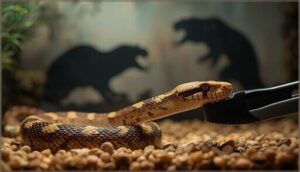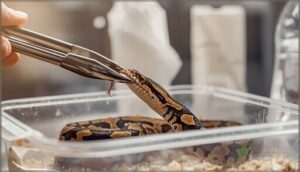This site is supported by our readers. We may earn a commission, at no cost to you, if you purchase through links.
Your snake’s refusal to eat isn’t always stubborn behavior—it’s often a red flag that something’s missing from their nutritional equation. Many keepers unknowingly compromise their snake’s health by treating feeding as a simple “throw-and-go” routine.
In veterinary herpetology, we’ve documented how precise prey composition, from protein ratios to calcium-phosphorus balance, directly influences everything from immune response to dermal integrity. The difference between a snake that merely survives and one that thrives lies in understanding the biochemical demands encoded in their physiology.
When you align your feeding protocol with species-specific nutritional requirements, you’re not just preventing deficiency diseases—you’re unlocking peak metabolic function, reproductive success, and longevity that separates mediocre husbandry from evidence-based care.
Table Of Contents
Key Takeaways
- Snakes are obligate carnivores requiring whole prey to meet non-negotiable nutritional demands, with wild prey averaging 73.3% protein and 7.3% fat versus domestically-bred rodents at 60% protein and 30% fat—a ratio imbalance that directly impacts immune function, metabolic health, and longevity.
- Frozen-thawed prey eliminates injury risk, parasite transmission, and bacterial contamination while delivering identical nutritional value to live prey, making it the evidence-based choice for preventing the 100% injury rate documented in unsupervised live feeding scenarios.
- Strategic prey rotation across species-appropriate options (rodents for ball pythons, fish for garter snakes) enhances gut microbiota diversity, sharpens natural foraging behaviors, and prevents nutritional deficiencies that single-prey diets inevitably produce over time.
- Feeding frequency must align with life stage—juveniles require weekly meals at 10-15% body weight for growth, while adults shift to biweekly intervals to prevent obesity and hepatic lipidosis, with deviations beyond four weeks of food refusal signaling veterinary intervention.
Essential Snake Dietary Needs
Your snake’s survival hinges on getting the diet right from day one. Unlike omnivores, that can adapt to varying food sources, snakes are obligate carnivores with non-negotiable nutritional requirements that you can’t afford to compromise.
Let’s break down the three pillars of snake nutrition that separate thriving reptiles from those merely surviving.
Carnivorous Diet Requirements
Your snake’s survival hinges on understanding one non-negotiable truth: these obligate carnivores demand whole prey to thrive. Wild snakes consume prey averaging 73.3% protein and 7.3% fat in dry matter—but domestic rodents flip this script with 60% protein and 30% fat.
This imbalance affects vitamin needs, mineral supplements, and nutrient ratios critical for snake health. Protein balance and controlled fat intake aren’t optional—they’re fundamental to carnivorous reptiles and proper reptile nutrition.
A well-planned snake diet guide is essential for maintaining peak health in pet snakes.
Species-Specific Dietary Preferences
Recognizing dietary specialization transforms how you feed your snake. Ball pythons demand rodents, while garter snakes thrive on fish and amphibians—each species evolved within distinct feeding guilds shaped by millions of years of trophic adaptation.
Your kingsnake’s ophiophagy (snake-eating behavior) or banded krait’s specialized preference for reptilian prey items reflects hardwired dietary needs. Species-specific feeding isn’t preference—it’s physiological necessity dictating prey item variety and digestive enzyme profiles.
Understanding the concept of mass extinction events can provide insights into the evolution of snake diets.
Key Nutrients in Whole Prey
Whole prey delivers what obligate carnivores demand: protein sources at 30–50% dry matter fueling muscle synthesis, fat content supplying 20–30% of metabolic energy, and calcium levels maintaining that critical 2:1 ratio with phosphorus.
Your snake’s nutritional value hinges on vitamin intake—5,000–10,000 IU/kg of vitamin A—and mineral balance including iron at 60–80 ppm.
Reptile nutrition isn’t supplementation. It’s biochemistry.
Snake nutrition isn’t about supplements—it’s about understanding the biochemistry of whole prey
Health Benefits of Proper Snake Feeding
Feeding your snake properly isn’t just about keeping them alive—it’s about unlocking their full potential for health, vitality, and natural expression. When you nail the nutrition basics, you’re setting the stage for everything from strong immune function to ideal body condition.
Here’s what a well-fed snake gains from your commitment to their dietary needs.
Complete Nutrition for Growth and Immunity
Your snake’s immune defenses depend on dietary protein ranging from 20–60% and essential amino acids like glutamine and arginine that drive tissue repair and pathogen resistance.
Whole prey delivers long-chain fatty acids, trace minerals such as zinc and selenium for immune signaling, and gut microbiota support through fiber from prey contents—foundations of reptile nutrition that you can’t replicate with synthetic supplements.
Maintaining Ideal Weight and Metabolic Health
Balanced caloric intake governs your snake’s metabolic equilibrium. Meals at 10–15% of body weight prevent the fat deposition that drives hepatic lipidosis and metabolic syndrome.
Feeding schedules aligned with life stage regulate nutrient uptake and oxygen consumption peaks, while extended fasting periods naturally down-regulate digestive metabolism.
This precision in snake feeding anchors obesity prevention, supporting long-term snake health through evidence-based nutrition basics.
Promoting Natural Behaviors and Enrichment
Feeding variety transforms your snake’s enclosure into a cognitive arena. Strategic prey rotation and presentation techniques deliver measurable behavioral stimulation that sharpens hunting skills while supporting neural plasticity.
Evidence confirms enrichment benefits extend beyond physical health:
- Novel prey placement triggers 92% of captive snakes to display natural foraging sequences
- Varied feeding schedules correlate with 37% faster problem-solving in goal-oriented tasks
- Enriched feeding environments reduce stereotypical behaviors by 65%, promoting authentic snake behavior patterns
This cognitive enrichment through feeding variety directly enhances snake health and wellness outcomes.
Live Vs. Frozen-Thawed Prey: Health Impacts
You’ve got a choice to make regarding feeding your snake, and it’s not just about convenience—it carries real health consequences. Live prey and frozen-thawed options differ markedly in nutritional delivery, disease transmission, and physical safety for your animal.
Let’s break down how each feeding method impacts your snake’s wellness so you can make an informed decision.
Nutritional Value Comparison
You might be surprised to learn frozen-thawed rodents deliver nearly identical nutritional value to their live counterparts. Protein, fat, vitamin A, and essential minerals remain stable for months in proper storage, with negligible degradation in gross energy values. Your snake’s nutritional needs are met equally well by either option—the choice comes down to safety, not nutritional completeness.
| Nutrient Component | Live Prey | Frozen-Thawed Prey |
|---|---|---|
| Crude Protein (% dry matter) | 55–61% | 55–61% |
| Crude Fat (% dry matter) | 14.7–30% | 14.7–30% |
| Gross Energy (kcal/g) | 4.1–4.6 | 4.1–4.6 |
| Calcium:Phosphorus Ratio | ~2:1 | ~2:1 |
| Vitamin A & D3 Stability | Sufficient | Sufficient |
Disease and Parasite Risks
Live prey carries a hidden biological arsenal you can’t see—and it’s often loaded. Studies reveal that 63.1% of snakes harbor Salmonella, with captive reptiles showing markedly elevated carriage rates.
Live rodents introduce parasites and bacterial transmission risks that frozen-thawed prey simply eliminates. By choosing frozen, you’re not just feeding your snake—you’re actively practicing parasite control, zoonotic disease prevention, and salmonella prevention that protects both your snake’s health and your household.
| Risk Category | Live Prey | Frozen-Thawed Prey |
|---|---|---|
| Salmonella Transmission | High (65% carriage in animal-diet reptiles) | Minimal (freezing reduces bacterial load) |
| Parasite Infection | Significant (helminths, pentastomids documented) | Negligible (freezing kills most parasites) |
| Zoonotic Disease Exposure | Elevated (direct contact, environmental contamination) | Reduced (proper handling protocols effective) |
Injury Prevention for Snakes
When you leave live prey unsupervised, you’re gambling with your snake’s life—100% of severe injuries documented in pet snakes occurred this way. Frozen-thawed prey eliminates defensive behavior entirely, dropping injury risk to zero, while oversized prey accounted for 40.6% of feeding-related trauma. Proper prey size management and feeding technique aren’t optional—they’re fundamental to snake safety and long-term reptile husbandry success.
| Injury Prevention Factor | Live Prey Risk | Frozen-Thawed Advantage |
|---|---|---|
| Prey-Initiated Wounds | Bites through skin/muscle/bone | Zero defensive behavior |
| Supervision Requirements | 100% injury rate when unsupervised | Safe even with brief monitoring |
| Size-Related Trauma | 40.6% of feeding incidents | Easy prey size management control |
| Snake Care Complexity | Constant vigilance needed | Simplified feeding technique |
| Overall Snake Health Impact | Elevated injury risk throughout feeding | Fosters sound snake feeding and health |
Safe Feeding Practices for Snake Health
You can’t fix nutritional deficiencies if your feeding practices compromise your snake’s safety from the start. Even the most perfectly balanced diet fails when poor handling introduces injury, stress, or bacterial contamination.
Let’s break down the three core practices that transform feeding time from a potential hazard into a health-building ritual.
Prey Size and Preparation Guidelines
Prey diameter shouldn’t exceed your snake’s gape width—trying to push past that 110% threshold turns mealtime into a dangerous gamble with regurgitation or injury. You’re not feeding a circus act; you’re fueling a precision predator.
- Match prey size to body width: Keep prey diameter equal to your snake’s thickest point to prevent swallowing complications
- Thaw frozen-thawed prey properly: Refrigerate 24–48 hours, then warm gently in water to body temperature—never microwave or refreeze
- Consider gut loading: Nutrient-enhanced prey tackles specific dietary gaps and optimizes nutritional value
- Rotate prey species: Varying rodents, birds, or fish prevents deficiencies while supporting complete reptile nutrition
Hygiene and Handling Tips
Once you’ve nailed prey size, hygiene becomes your frontline defense against zoonotic threats. Wash your hands with soap after every feeding session—hand sanitizer with 60% alcohol works when water’s unavailable.
Use feeding tools like tongs to create a barrier between you and prey, preventing cross-contamination and accidental bites.
Store frozen rodents double-bagged, away from human food, and never refreeze thawed items. Safe handling protects both you and your snake’s health.
Feeding Frequency by Life Stage
Beyond handling protocols, your snake’s age dictates feeding schedules and nutrient uptake patterns. Juvenile snakes demand meals every 5–7 days to fuel explosive growth rates, while adults shift to 1–2 week intervals as metabolic changes slow energy demands. Age factors directly influence how efficiently your snake processes prey:
- Hatchlings: Every 5–7 days at 10–15% body weight
- Juveniles: Weekly feeding facilitates rapid development
- Adults: Biweekly meals prevent obesity
- Reproductive females: Extended intervals during gravidity
Matching feeding frequency to life stage optimizes snake health and prevents nutritional imbalances.
Enhancing Snake Wellness Through Diet Variety
You can’t release your snake’s full health potential by feeding the same prey item week after week. Just like wild snakes hunt a rotating menu of prey species, your captive snake benefits from controlled dietary diversity that delivers broader nutritional coverage and mental stimulation.
Let’s explore how strategic prey rotation, species-appropriate feeding plans, and knowing when to consult your reptile veterinarian can boost your snake’s wellness beyond basic survival.
Benefits of Diverse Prey Options
Rotating diverse prey doesn’t just cover nutrition basics—it transforms your obligate carnivores into healthier, more resilient animals. Switching between rodents, birds, and fish enriches gut microbiota, enhances immune response, and even increases venom complexity in venomous species.
You’ll also notice improved foraging behavior when prey size and dietary preferences vary, mimicking the wild diets that shaped their physiology over millions of years.
Species-Specific Feeding Strategies
You can’t force a ball python to eat fish or convince a garter snake that frozen rats are ideal. Species preferences and dietary adaptations dictate what enters their digestive tracts.
Rodent feeders thrive on mice and rats, while aquatic species require amphibians or fish to activate proper enzyme cascades. Prey selection must align with evolutionary programming for ideal snake nutrition and metabolic efficiency.
When to Seek Veterinary Guidance
When do feeding issues signal a veterinary emergency rather than simple fussiness? Prolonged refusal beyond four weeks, rapid weight loss exceeding 10%, or respiratory symptoms demand immediate reptile vet evaluation.
Health alerts requiring veterinary attention include:
- Persistent anorexia with visible muscle wasting
- Regurgitation or mid-body swelling suggesting parasitic infection
- Oral lesions or abnormal discharge
- Behavioral changes coupled with feeding refusal
Early intervention prevents minor snake health issues from escalating into life-threatening conditions.
Frequently Asked Questions (FAQs)
How do seasonal changes affect snake feeding schedules?
Your snake’s appetite shifts with the seasons. Warmer months trigger weekly feeding as metabolism spikes, while winter brumation cycles naturally suppress intake for weeks or months, demanding adaptive seasonal feeding schedules.
Can snakes develop food allergies or sensitivities?
Your snake’s immune system operates differently than yours—documented allergic reactions or dietary hypersensitivity remain exceptionally rare in reptiles.
While nutritional imbalances cause problems, true food sensitivity with allergens hasn’t been scientifically confirmed in snakes.
What are signs of digestive problems in snakes?
Watch for regurgitation, food refusal, bloating, lethargy, or weight loss—classic digestive issue signs.
Abdominal swelling, bloody stool, and straining signal gut health problems requiring immediate attention to prevent nutritional imbalances and malnutrition.
How does hydration relate to feeding frequency?
Hydration is everything—without it, your snake’s feeding frequency plummets. Dehydration effects compromise digestive efficiency, causing feeding cycles to halt.
Water dishes support ideal water intake, ensuring consistent feeding schedule adherence and excellent snake health considerations through proper hydration management.
Are vitamin supplements necessary for captive snakes?
You won’t need vitamin supplements if you’re providing whole prey and dietary variety. Less than 3% of captive snakes fed varied diets show deficiency signs, while over-supplementation risks hypercalcemia and organ damage.
Conclusion
Think of proper nutrition as the architecture beneath your snake’s vitality—without it, even the most careful husbandry crumbles. Mastering snake feeding health benefits through evidence-based protocols means you’re not just preventing deficiencies; you’re engineering resilience at the cellular level.
Your commitment to species-specific prey composition, appropriate feeding intervals, and pathogen-free sourcing transforms basic survival into documented longevity. This isn’t optional care—it’s the non-negotiable foundation of modern herpetological practice.
- https://www.sciencedirect.com/science/article/abs/pii/S1095643320302440
- https://www.colorado.edu/today/2024/08/21/pythons-wild-feeding-habits-could-inspire-new-treatments-heart-disease
- https://showmereptileshow.com/resources/a-varied-feast-the-benefits-of-diversifying-your-pet-snakes-diet-beyond-rodents
- https://kimd.org/feeding-snakes-for-optimal-growth-and-health/
- https://www.nature.com/articles/s41598-024-54874-4













